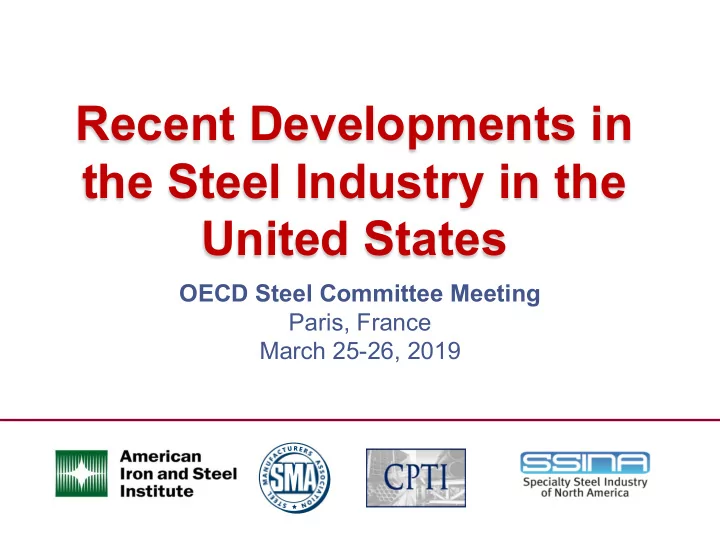

Recent Developments in the Steel Industry in the United States OECD Steel Committee Meeting Paris, France March 25-26, 2019
Economic Conditions are Robust and the Industrial Economy is in the Midst of a Broad-Based Rebound Gross Domestic Product (GDP) Industrial Production (IP) Sources: BEA, IHS Markit Sources: Federal Reserve, IHS Markit 4% 6% 5.5% 4% 3% 4.0% 2.9% 2.9% 3.1% 3.1% 3.0% 2% 2.7% 2.5% 2.0% 1.6% 1.5% 2.6% 2.5% 2.4% 2% 2.2% 2.2% 2.0% 0% 1.9% 1.8% Percent Change -1.0% -1.9% 1.6% 1.6% -3.5% 1% -2% -4% 0% -0.1% -6% -1% -8% -2.5% -11.5% -2% -10% -3% -12% 2007 2008 2009 2010 2011 2012 2013 2014 2015 2016 2017 2018 2019 2020 2007 2008 2009 2010 2011 2012 2013 2014 2015 2016 2017 2018 2019 2020 2
U.S. Steel Market Highlights • Despite recent trade actions, steel imports continue to capture significant U.S. market share and distort markets • U.S. direct steel trade deficit remains elevated – Finished imports captured 22.9 percent of the U.S. market in 2018, the lowest level since 2011 – Imports of two key product areas saw double-digit increases in 2018: hot-rolled sheet (up 22 percent) and plates in coil (up 15 percent) • Production and capacity utilization have increased, but have not yet reached pre-recession levels • Steel companies are reinvesting in U.S. steelmaking facilities to meet robust market demand. Others have reduced capacity or exited the market 3
Apparent Steel Demand is Rebounding, but Has Not Fully Recovered to Pre-Recession Levels U.S. Apparent Steel Use (ASU) Sources: U.S. Census Bureau, American Iron and Steel Institute 120 110.6 108.8 100 101.8 100.7 99.7 98.0 98.0 97.6 93.9 90.9 Million Metric Tons (MMT) 80 81.8 60 60.8 40 20 0 2007 2008 2009 2010 2011 2012 2013 2014 2015 2016 2017 2018 4
Steel Shipments Increasing But Remain Below Pre-Recession Levels U.S. Steel Mill Shipments 120 Source: American Iron and Steel Institute 100 96.6 Million Metric Tons (MMT) 89.4 89.1 87.0 86.6 86.4 80 83.3 82.5 78.5 78.5 75.7 60 56.4 40 20 0 2007 2008 2009 2010 2011 2012 2013 2014 2015 2016 2017 2018 5
Capacity Utilization has Trended Higher Recently but Remains Low by Historical Standards U.S. Raw Steelmaking Capacity Utilization Source: American Iron and Steel Institute 100 The Lost Decade 90 Capacity Utilization (%) 80 70 60 50 Great Recession Begins 40 1995 1996 1997 1998 1999 2000 2001 2002 2003 2004 2005 2006 2007 2008 2009 2010 2011 2012 2013 2014 2015 2016 2017 2018 6
U.S. Steel Imports Have Remained at Elevated Levels for Past Five Years U.S. Steel Imports Sources: U.S. Census Bureau, American Iron and Steel Institute 45 35% 40 30% Finished Import Market Share (%) 35 Million Metric Tons (MMT) 25% 30 20% 25 20 15% 15 10% 10 5% 5 0 0% 2007 2008 2009 2010 2011 2012 2013 2014 2015 2016 2017 2018 Semi-Finished Imports (LHS) Finished Imports (LHS) % Market Share (RHS) 7
U.S. Finished Steel Exports at Lowest Level Since 2009 U.S. Finished Steel Exports 14 Source: U.S. Census Bureau 12 11.7 11.7 11.3 11.1 10.6 Million Metric Tons (MMT) 10 10.4 9.7 9.4 8.9 8 8.3 7.9 7.8 6 4 2 0 2007 2008 2009 2010 2011 2012 2013 2014 2015 2016 2017 2018 8
From 2014-18, U.S. Direct Steel Trade Deficit Exceeded 20 Million Metric Tons Annually U.S. Direct Steel Trade Balance Source: U.S. Census Bureau 2007 2008 2009 2010 2011 2012 2013 2014 2015 2016 2017 2018 0 -5 Million Metric Tons (MMT) -10 -15 -20 -25 -30 Semi-Finished Steel Trade Balance Finished Steel Trade Balance -35 9
International Efforts to Reduce Global Steel Overcapacity • Global excess capacity remains a serious problem and continues to plague steelmakers in the United States and other markets – U.S. industry supports continued efforts of governments at the Global Forum on Steel Excess Capacity and Trilateral negotiations to address subsidies and market-distorting practices • However, renewed efforts should achieve: (1) Meaningful net reductions in uneconomic capacity (2) Elimination of government subsidies and other market- distorting policies and practices in the steel industry (3) Effective trade remedies and enforcement 10
U.S. Steelmaking Capacity Has Remained Remarkably Stable Since 2000 U.S. vs. World Steelmaking Capacity 2,500 2,000 Million Metric Tons (MMT) 1,500 1,000 World U.S. 500 0 2000 2001 2002 2003 2004 2005 2006 2007 2008 2009 2010 2011 2012 2013 2014 2015 2016 2017 2018* 2018* estimate Source: OECD 11
State-Supported Steel Production Continues to Challenge Market-Based U.S. Steelmakers • Global steel excess capacity continues to distort steel markets worldwide • Steel production and exports continue to be supported by subsidies and other measures • U.S. steelmakers favor effective solutions to get governments out of the business of supporting uneconomic capacity expansions • Urgent action by governments are needed to address this critical situation 12
Recommend
More recommend